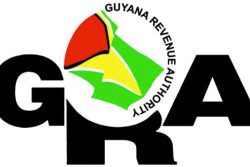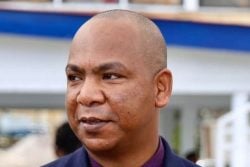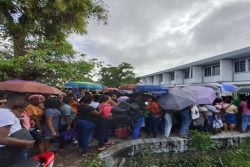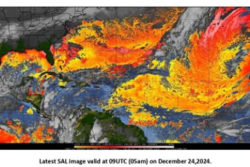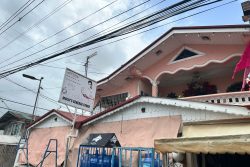WASHINGTON, (Reuters) – A NASA astronaut was flown to a hospital with an unspecified medical issue yesterday shortly after returning to Earth from a nearly eight-month mission on the International Space Station, the U.S. space agency said.
The astronaut, who NASA did not name for privacy reasons, had splashed down off Florida’s coast at 3:29 a.m. ET (0729 GMT) on Friday aboard SpaceX’s Crew Dragon capsule with three other crew members – two NASA astronauts and a Russian cosmonaut.
The crew included U.S. astronauts Matthew Dominick, Michael Barratt, and Jeanette Epps, and Russian cosmonaut Alexander Grebenkin. Their 235 days in space made it longer than the usual six-month ISS mission duration and marked the longest stay in orbit for SpaceX’s reusable Crew Dragon spacecraft.
NASA initially said the entire crew was transported to the medical center for additional evaluation and out of an abundance of caution, but did not specify whether all or a portion of the crew had been experiencing issues.
NASA later said it was one of its astronauts who experienced a medical issue and that the crew had been flown to a hospital in Pensacola, Florida, near the splashdown site. The three other crew members have since left the hospital and returned to Houston, the space agency said.
“The one astronaut who remains at Ascension is in stable condition under observation as a precautionary measure,” NASA said in a statement, referring to Ascension Sacred Heart Pensacola hospital. The agency said it will not share the nature of the astronaut’s condition.
Russia’s space agency, Roscosmos, posted on the social messaging platform Telegram a photo of Grebenkin standing upright and smiling, with a caption reading: “After a space mission and splashdown, cosmonaut Alexander Grebenkin feels great!”
The crew’s return from the football field-sized science lab 250 miles up in orbit had been delayed for weeks because of two hurricanes that swept through the U.S. southeast near Crew Dragon’s expected splashdown zones.
SpaceX maintains a fleet of reusable spacecraft and has flown to the ISS 44 times.
The Elon Musk-owned company remains the only U.S. option for NASA astronaut trips to and from the ISS. Boeing’s BA.N Starliner, intended as a second U.S. ride, has been hobbled by years of development issues.
Crew Dragon safely undocked from the ISS on Wednesday afternoon and reentered Earth’s atmosphere early Friday morning, deploying parachutes before plunking into the Gulf of Mexico.
At a post-splashdown news briefing, a NASA official said “the crew is doing great” and made no mention of any issues with the astronauts. He noted two hitches with Crew Dragon’s parachute deployment.
Richard Jones, deputy manager of NASA’s Commercial Crew Program, said Crew Dragon’s initial set of braking parachutes suffered some “debris strikes” and that one of four parachutes in a subsequent set took longer than expected to unfurl.
Neither event affected crew safety, Jones said, calling the splashdown weather “ideal” for the crew’s recovery.
The crew’s reusable Crew Dragon spacecraft was on its fifth flight, logging 702 days in orbit since its first mission, SpaceX’s vice president of flight reliability, William Gerstenmaier, a former senior NASA official, told reporters during the news conference.
Miller said he has told visa officials to be more rigorous and restrictive in processing applications.
“Injecting a little more discipline into the system was important, and making sure that the visa process is a little more rigorous … It means being more restrictive in the visas that we give to people and who we give them to.”
WORKFORCE WORRIES
Some economists welcomed these immigration cuts, aimed at easing strain on housing and social services, but industry groups worry it could hurt Canada’s labor force.
“Every chamber of commerce always wants more people, and I think largely we have listened to them,” Miller said. But “as the federal government, we have a responsibility of looking at the economy and saying, ‘Well, where has this gotten a little overheated?'”
Miller said he does worry about the healthcare workforce, and he hopes provinces will work with the federal government to fill needed spots.
Canada’s temporary foreign worker program has come under fire for the ways it makes vulnerable workers, tied by visas to their employers, subject to abuse. A United Nations representative called it a “breeding ground for contemporary forms of slavery.”
Miller said he is considering permits that would allow workers to switch employers within a sector.
“There have been abuses,” he said. “I think we do have a role to play federally in perhaps looking at more sectoral work permits … This is work that is in progress.”
The immigration levels plan is not rash, Miller said.
“We have been working on this for a long time … Perhaps if we’d taken draconian measures last year, that would rightly have been characterized as reactive,” he said. “But we wanted to get this right, particularly when it comes to permanent residency because of its value to Canadians.”
A new three-year plan will be released next year.
“None of these plans are ever, for the three-year period, fixed in stone.”
